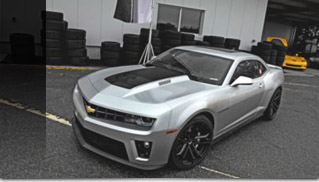 DETROIT – With supercar levels of performance and technology, the 580-horsepower (432-kW) Camaro ZL1 can reach 170 mph (273 km/h) on the famed Nürburgring’s Nordschleife course in Germany. To maintain stability and steering response at that speed, the ZL1 features an aerodynamic design that generates downforce to press the tires against the track.
DETROIT – With supercar levels of performance and technology, the 580-horsepower (432-kW) Camaro ZL1 can reach 170 mph (273 km/h) on the famed Nürburgring’s Nordschleife course in Germany. To maintain stability and steering response at that speed, the ZL1 features an aerodynamic design that generates downforce to press the tires against the track.
“The Camaro ZL1 lapped the Nürburgring in an incredible 7:41.27 seconds, which would not have been possible without work of our aerodynamics team,” said Al Oppenheiser, Camaro chief engineer. “The design of the ZL1 creates downforce like a race car, harnessing air pressure to press the tires against the track for extra grip and control at high speeds.”
Most production cars are designed with some lift at speed slip through the air for improved fuel economy. The Camaro LS and Camaro SS are no exceptions, enabling the Camaro LS to deliver 323 horsepower (241 kW) and up to 30 mpg on the highway.
Design for high-speed track capability takes in other considerations.
For the ZL1 – the fastest Camaro ever – the aerodynamics team set out to generate downforce for improved handing at speed while minimizing the amount of increased drag that could reduce fuel economy and the vehicle’s top speed. With the computer-assisted design recommendations, engineers tested full-scale clay models and full-size prototypes in the General Motors’ wind tunnel – shaping clay and trimming foam board by hand to affect changes and measure them immediately.
Outside of the aerodynamics laboratory, engineers tested the ZL1’s aero aids on GM’s Milford Road Course, other race tracks and the unique “rolling road” wind tunnel at the Auto Research Center in Indianapolis.
When the dust settled and the wind-tunnel blades came to a stop, the Camaro ZL1 produced 65 pounds of downforce at an equivalent 150 mph (241 km/h) – compared to 200 pounds of lift in a Camaro SS – which was offset by an increase of only 40 counts of additional aerodynamic drag. Read more! Watch the video!
“From the driver’s seat, the added downforce makes a huge change in the feel, and responsiveness of the ZL1 at high speeds,” said Oppenheiser. “One of the best examples of how aerodynamics improved the performance of the ZL1 is the ‘Fuchsröhre,’ or Foxhole at the Nürburgring. In the ZL1, you can take that sweeping left-hand corner flat-out in fifth gear – nearly 160 mph (257 km/h). That’s a great testament to the confidence-inspiring stability and control the aerodynamic design helps give the Camaro ZL1.”
Seven elements contribute to the downforce of the ZL1:
1. Front fascia – The front fascia channels air for engine and brake cooling. The lower opening is larger than in a Camaro SS, providing greater airflow to the engine’s intercooler heat exchanger. Even the grille “fins” were shaped for optimal airflow. The corners of the front fascia, too, were reshaped to minimize lift, while the brake-cooling ducts in the outer corners of the lower grille opening provide a direct, high-flow path to the brake rotors. Cooling the brakes helps extend their life, particularly n the race track.
2. Hood – The ZL1’s hood has a vented, carbon fiber insert, contributing to both engine cooling and aerodynamic downforce. With traditional sealed hoods, air trapped in the engine bay creates lift at the front axle. With the ZL1, the specially shaped vents draw air up through the engine bay – allowing a significant volume of air flow while keeping the front tires firmly connected to the pavement.
3. Front splitter – Instead of a traditional front air dam, the ZL1 incorporates a racing-style splitter to help create downforce. Unlike some competitors’ vehicles that come with an add-on splitter, the ZL1’s does not have to be installed at the track – it is installed at the factory, and is designed with enough ground clearance for all driving conditions.
4. Front tire deflectors – The deflectors push airflow around the rotating wheels and tires more efficiently, reducing lift and drag. And by using deflectors in place of a traditional air dam, the downforce is less sensitive to pitch changes, making the ZL1 feel more stable at high speeds.
5. Belly pans – The ZL1 has two of them: one beneath the engine cradle and one at the rear of the engine assembly, just in front of the transmission. Both extend the width of the chassis out to the wheelhouse opening, to minimize airflow turbulence under the car. NACA-style ducts are incorporated into the rear belly pan for transmission cooling.
6. Rocker panels – Although subtle in appearance, the carefully shaped rocker panels help reduce lift and drag, while also contributing to stability during high cross winds. They also provide stone protection with the ZL1’s wider tires.
7. Rear spoiler – One of the most dramatic aero enhancements comes with the ZL1’s rear spoiler, which contributes approximately 150 pounds of down force at the cost of only 1 count of drag. It is taller and wider than the Camaro SS spoiler and incorporates the center high-mounted stop lamp.
The Camaro ZL1 goes on sale later in 2012. A convertible model will also be offered for the 2013 model year, starting in the summer of 2012. Pricing will be announced later.